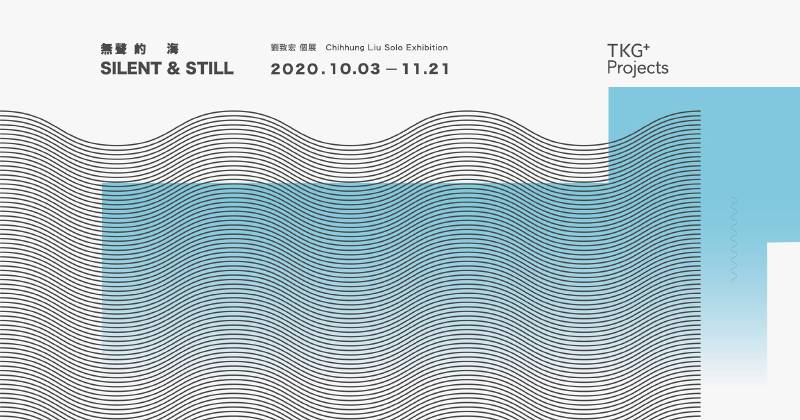TKG+
【無聲的海—劉致宏個展】Chihhung Liu: Silent and Still

-
展期
日期:2020-10-03 ~ 2020-11-21
-
地點
台北市內湖區瑞光路548巷15號2樓
-
參展藝術家
劉致宏
-
展期 │10/3/2020 - 11/21/2020
地點 │TKG+ Projects,台北市內湖區瑞光路548巷15號2樓
劉致宏過往創作中,大多取材自生活周遭的碎片:巷弄中的盆栽、偶然遇見的風景、異地旅行時撿拾的話語,甚至是蚊蟲屍骸。這些凡常的碎片以繪畫、裝置、計畫等不同媒材表達呈現。劉致宏尤其擅長將這些「生活中的碎片」藉由獨到的美學觀、敏銳直覺重新編碼,轉譯為帶有語言形象的作品。藝術家將其理解為個人創作中的不同文類:短篇小說、詩、散文……等等。這種轉譯的技術,除了連結藝術家身體與作品間的關係──藉由身體進行之書寫勞動,亦表達「語言」堆疊時所衍生之情感上的感知──恰似流轉在語言之間的音韻或字元的形狀、排列組合帶來情感上難以言說的感受。更細緻地描述,劉致宏的轉譯方法,以接近書寫的身體行動,將採集的「生活碎片」轉換成看似可以被閱讀的形式。
劉致宏的這套編碼與轉譯,並不求意義的完全傳達,亦非將採集之碎片背後深意進行表述。而是藉由此般編碼與轉譯系統,設計一套「視覺語言」。無論是將聲音以圖像記寫記錄下來、將姿態各異的蚊蟲屍體作為字元進行排列、或是以繪畫語言表現在畫布上書寫的當代日常。許多因轉譯而造成的意義空缺,則被如同「密碼/另一種語言」所層疊出來的感覺所填充。這就像凝視著古代文明所遺留的碑文,在符號、文字未被破譯理解前,率先洶湧襲來的神祕感受。也因為其無法被明確翻譯的特質,這些作品看似輕描淡寫、化整為零,但是編碼集合所加乘的感受,卻比原有的文本說得更多更遠。
「無聲的海」望向的是一片當代經驗、遙遠彼方的「海」的意象,經由創作與書寫的過程,與文本保持忽遠忽近的距離,替作品創造更多容納抽象情感的空間。在本次展覽中,劉致宏使用聲波、閃燈訊號、電碼、旗號等作為部分創作的靈感,也藉此提示「時間」、「距離」、「意圖」與何謂「海」的存在。另一部分,透過身體勞動,將密碼的編譯作為各種「書寫行動」。以此書寫行動為標線,進而向遠方延伸、透過觀景窗所見的那一處彼方,便是劉致宏創作脈絡中對文學性的想像──更深入地追究,甚至與其繪畫思考相關。這個想像關係到,藉由字元的形狀、語言的排列組合(無論是視覺或聽覺)、 書寫者的身體感以及觀眾閱讀時的身體感受,在敘事與意義外觸動感性。這也與回到劉致宏繪畫創作中進行的努力息息相關:透過身體的勞動書寫、透過筆觸留下身體感,並試圖讓觀眾通過筆觸去還原、想像繪畫過程身體運動的方式。劉致宏所陳列的諸多碎片,也藉由這般書寫行動(或源自繪畫的美學觀),篩選過濾掉大部分的雜訊,見微知著地將細微情感放大顯現。
「無聲的海」可以視為個人的脈絡整理,亦將過往分置於不同展覽的創作類型(繪畫、裝置、計畫型創作、行動),更有意識地凝結且標示彼此的關係,收攏於同一條脈絡線上。觀眾或可在這次展覽中,窺見藝術家處理不同媒材時,如何藉由編碼與轉譯、作品提供的可辨識的線索,帶領觀者踏上那一片遠方海洋的遙望。
關於劉致宏
劉致宏,生於臺灣新竹。現職自由藝術工作者,生活、工作與創作於臺北。劉致宏近年的繪畫創作持續關注在生命的體認與生活經驗的捕捉,用日常的角度編構敘事並賦予詮釋,讓情感與圖像緊密扣合。他的創作類型涵括了繪畫、裝置、影像、現成物、印刷出版物等,並聚焦討論在「材料/拾得/能動性」、「語言形式的轉化」與「在地關係連結」 等面向。近期個展於橫濱象鼻公園(2019)、慕尼黑藝術公寓(2018)、東京日動畫廊當代館(2018)、台北國際藝術村(2016)、台北市立美術館(2014)…等。
----------
Chihhung Liu: Silent and Still
Exhibition Dates│10.03.2020 - 11.21.2020
Venue│TKG+ Projects, 2F, No. 15, Ln. 548, Ruiguang Rd., Neihu Dist., Taipei, Taiwan 114
Chihhung Liu’s previous body of work is largely inspired by daily life: potted plants in the alley, serendipitous scenery, words and phrases picked up during travels, even dead mosquitoes. These minutiae manifest themselves in the form of painting, installation, or special projects. The artist translates these fragments of the everyday into a body of work coded with linguistic elements through his unique aesthetics and instincts. Each work in his interpretation belongs to a different literary genre: short story, poetry, or prose. This reinterpretation technique, in addition to connecting the artist’s body to his work — the physical action of writing conveys the emotional perception derived from the accumulation of linguistic elements — elicits an ineffable feeling, just like how the rising and falling of intonation, the shape of a character, or the permutation of characters does. Through a physical action that mimics writing, the artist transforms prosaic fragments into a form that is seemingly decipherable.
The artist does not seek to convey the meaning in its entirety, or to express the connotation hidden within these fragments of the everyday. Instead, he has designed a visual language according to his own coding system, whether to document sounds in the form of images, to arrange peculiar-looking dead mosquitoes into characters, or to translate ordinary experiences onto canvas in the form of painting. This act of translation triggers a lack of meaning, occupied by a faint grasp of what appears to have been encrypted or written in another language. Much like how one becomes awash in awe gazing at ancient inscriptions, when symbols and characters were yet to be deciphered. While on the surface it looks frivolous due to its inexplicable nature, Liu’s ciphered work evokes a sensation that far exceeds what the respective elements in the work could have brought.
Chihhung Liu: Silent and Still examines the imagery of the sea by delving into contemporary experiences. In the process of art making and writing, the artist creates space for abstract emotions within his work by maintaining a distance from his references, such as Liu’s own field research, sea shanties, and Mishima Yukio’s novel The Sailor Who Fell from Grace with the Sea. Inspired by sound waves, flashing light signals, flag signals, and codes, he investigates the ideas of time, distance, intent, and the existence of the sea. His various acts of writing, rooted in a coding system of his own, lend a literary tone to his work — even shed light on how he sees painting, on a deeper level. The shape of a character, the permutation of linguistic elements (visual or auditory), the artist’s physical awareness when he writes, along with viewers’ physical awareness when they read — together — triggers sensibility beyond the work’s narrative and meaning. This is also closely related to Liu’s painting practice: Through the manual labor of writing, he leaves behind a sense of the body through brushstrokes, allowing the viewer to imagine the way the artist’s body moves during the painting process. What he ultimately presents — filtered through the act of writing, through his aesthetics derived from painting — is a microcosm of nuanced emotions.
Silent and Still can be seen as the artist’s personal milepost, which comprises his different works in diverse mediums, from painting to installation, from project-based work to art activism. The viewer can perhaps glimpse how Chihhung Liu consciously highlights the relationship between each work, by coding and translating the clues embedded in the works, as he segues from one medium to the next in his effort to conjure the sea.
About Chihhung Liu
Born in Hsinchu, Taiwan, Chihhung Liu lives and works in Taipei, Taiwan. His recent painting practice distills everyday experiences into a personal understanding of life where ordinary narratives are told with a nuanced perspective, while emotions and images coalesce in his work. He straddles across a wide range of mediums, such as painting, installation, moving image, found objects, and print publications. His practice revolves around materials/found-objectness/agency, the shift between mediums, as well as a connection to the local community. He has exhibited internationally, including at the Zou-no-hana Terrace, Yokohama, Japan (2019), Apartment of Art Munich, Munich, Germany (2018), Nichido Contemporary Art, Tokyo, Japan (2018), Taipei Artist Village, Taipei, Taiwan (2016), and Taipei Fine Arts Museum, Taipei, Taiwan (2014).

